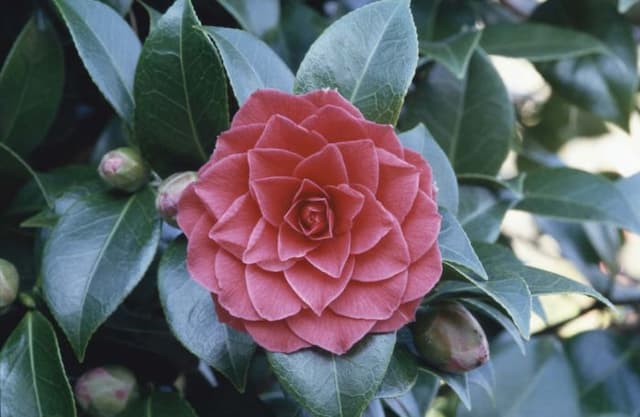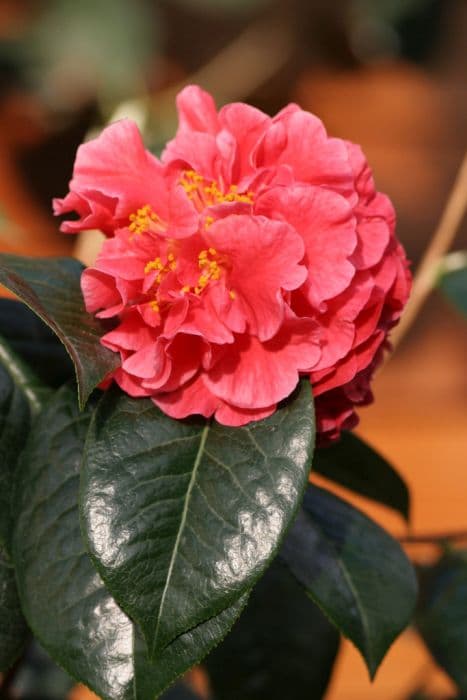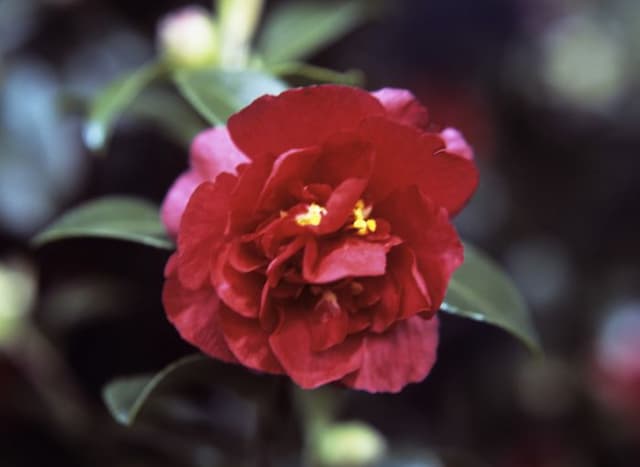Williamsii Camellia Camellia × williamsii 'Leonara'

ABOUT
The Camellia 'Leonara' is an evergreen shrub known for its beautiful floral display and glossy, dark green foliage. The leaves are leathery in texture, oval-shaped, and have a smooth edge that contributes to the plant's refined appearance. When it blooms, typically in the late winter to early spring, 'Leonara' produces large, eye-catching flowers. These blooms are a delight to behold, with their overlapping petals that create a full, rounded appearance. The petals themselves are a soft pink hue, at times almost pale, while some varieties may have deeper shades. Their texture is waxy, contributing to a lustrous sheen that makes the flowers stand out against the foliage. The buds of 'Leonara' are also quite appealing, emerging as pointed and elegant before they unfurl into the magnificent blooms that characterize this hybrid. The overall aesthetic of 'Leonara' is one of classic beauty, lending a touch of elegance to any garden where it thrives—often becoming a centerpiece around which other garden plants are arranged.
About this plant
 Names
NamesFamily
Theaceae.
Synonyms
Leonard Messel Camellia.
Common names
Camellia × williamsii 'Leonara'.
 Toxicity
ToxicityTo humans
Camellia × williamsii 'Leonara', commonly known as Williamsii Camellia, is not considered toxic to humans. There are no significant symptoms of poisoning associated with this plant, as it is generally recognized as safe to have around humans without the risk of toxic ingestion.
To pets
Williamsii Camellia is also not considered toxic to pets. This means that ingestion of this plant by animals such as dogs and cats should not cause any significant symptoms of poisoning. It is regarded as a safe plant in gardens and homes where pets may be present.
 Characteristics
CharacteristicsLife cycle
Perennials
Foliage type
Evergreen
Color of leaves
Green
Flower color
Pink
Height
6-10 feet (1.8-3.0 meters)
Spread
5-9 feet (1.5-2.7 meters)
Plant type
Shrub
Hardiness zones
7-9
Native area
East Asia
Benefits
 General Benefits
General Benefits- Aesthetic Appeal: Camellia × williamsii 'Leonara', commonly known as Camellia, enhances gardens with its attractive, glossy green leaves and large, showy flowers that bloom in late winter to early spring.
- Long Blooming Season: Camellias have a lengthy flowering period compared to many other plants, providing color and interest in the garden during times when other plants may be dormant.
- Versatility in Landscaping: Camellia can be used in a variety of landscaping applications, such as specimen plantings, hedges, foundation plantings, or as a backdrop for other flowers in a mixed border.
- Shade Tolerance: This plant can thrive in partially shaded environments where other flowering plants may struggle. This makes it a good choice for woodland gardens or shady areas.
- Drought Tolerance: Once established, Camellias are relatively drought tolerant, requiring less watering and maintenance than many other ornamental plants.
- Attracts Pollinators: The flowers provide nectar for pollinators such as bees, which are essential for the health of the garden ecosystem.
- Resistance to Pests: Camellias are generally resistant to many pests and diseases, minimizing the need for chemical treatments and making them a more eco-friendly landscaping choice.
 Medical Properties
Medical PropertiesThis plant is not used for medical purposes.
 Air-purifying Qualities
Air-purifying QualitiesThis plant is not specifically known for air purifying qualities.
 Other Uses
Other Uses- Biodegradable tools: The wood of the camellia can be used to create biodegradable garden tools or utensils, offering an eco-friendly alternative to plastics.
- Floral perfumery: The petals of the camellia flower can be incorporated into potpourri or used to infuse oils with a delicate floral scent for natural perfumes.
- Artistic inspiration: Artists and photographers often use the camellia's beauty as a subject for paintings, illustrations, and photographs.
- Educational resource: Camellia plants are sometimes utilized by schools or botanical gardens for educational purposes to teach botany and plant biology.
- Symbolic gifts: In certain cultures, giving a camellia plant can convey a message of admiration or perfection, making it a meaningful gift.
- Reverential uses: The camellia is sometimes used in religious or spiritual ceremonies as a symbol of purity or divine beauty.
- Plant grafting: The camellia can be used as a rootstock for grafting other species of the same genus to improve plant vigor or disease resistance.
- Specialized honey: Bees that pollinate camellias can produce a unique honey, which is highly valued in some regions for its distinctive taste.
- Microclimate enhancer: Planting camellias can help create a favorable microclimate in gardens, providing shade and humidity for other plant species.
- Dye production: Petals of some camellia varieties can potentially be used to create natural plant dyes for textiles or crafts.
Interesting Facts
 Feng Shui
Feng ShuiThe plant_name is not used in Feng Shui practice.
 Zodiac Sign Compitability
Zodiac Sign CompitabilityThe plant_name is not used in astrology practice.
 Plant Symbolism
Plant Symbolism- Admiration: Camellias are often associated with admiration and perfection, making them a symbol of the qualities that are respected and revered in others.
- Perfection and Excellence: Due to their lush blossoms and impeccability, they often represent an ideal or a standard of excellence that one strives to attain.
- Deep Desire: The rich colors and velvety petals can signify deep desire or passion, suggesting strong feelings towards someone.
- Enduring Love: Camellias have a long blooming season, which symbolizes the enduring nature of love, suggesting a relationship that stands the test of time.
- Refinement: This plant exudes an air of sophistication and purity, making it emblematic of refined beauty and gentleness.
 Water
WaterWilliamsii camellias, such as 'Leonara', prefer consistent moisture but do not thrive in waterlogged soil. Watering should occur when the top inch of soil feels dry, which typically means watering about 1-2 times a week, depending on weather conditions. During hot, dry periods, increased frequency may be necessary. Use about 1-2 gallons per plant for each watering session, ensuring you water deeply to encourage strong root growth. During the winter, reduce watering as the plant will require less moisture due to cooler temperatures and potential rainfall.
 Light
LightWilliamsii camellias like 'Leonara' perform best in partial shade, receiving protection from the intense afternoon sun. A spot that offers dappled sunlight or light shade, such as on the east or north side of a building or beneath the canopy of filtered-light trees, is ideal. They can tolerate morning sun, but direct sunlight during the hottest part of the day can be harmful.
 Temperature
TemperatureFor Williamsii camellias such as 'Leonara', the ideal temperature range is between 60 to 75 degrees Fahrenheit. While they can endure short periods of colder weather, they should be protected from temperatures below 20 degrees Fahrenheit. They are generally hardy in USDA zones 7 to 9, where temperature extremes are typically within their survival range.
 Pruning
PruningPrune Williamsii camellias like 'Leonara' to maintain shape and promote vigorous growth. The best time to prune is just after they finish blooming in late winter to early spring, as pruning later can remove next season's flower buds. Prune as often as needed to remove dead or weak branches and to shape the plant, but generally, annual pruning is adequate.
 Cleaning
CleaningAs needed
 Soil
SoilWilliamsii camellias require acidic soil with a pH of 5.5 to 6.5. A mix of peat moss, pine bark, and perlite or sand in equal parts is ideal to ensure good drainage while retaining moisture.
 Repotting
RepottingWilliamsii camellias should be repotted every 2-3 years, preferably in the spring after flowering. This frequency ensures they are not root-bound and can continue to thrive.
 Humidity & Misting
Humidity & MistingWilliamsii camellias prefer high humidity levels, around 50-60%. Mist the leaves regularly or use a humidity tray to maintain these conditions without affecting the watering schedule.
 Suitable locations
Suitable locationsIndoor
Position in bright, indirect light and maintain high humidity.
Outdoor
Plant in partial shade with shelter from strong winds.
Hardiness zone
7-9 USDA
 Life cycle
Life cycleCamellia × williamsii 'Leonara', also known as Williamsii camellia, begins its life cycle as a seed, which germinates in moist, well-drained soil. The seedling emerges and establishes its root system, before developing into a young plant with characteristic glossy, evergreen leaves. The camellia goes through a period of vegetative growth, after which it reaches maturity and begins to produce buds, typically in the fall. These buds blossom into large, showy flowers throughout winter and into early spring, ranging in color from white to pink and red. After pollination, often by bees, the flowers develop into seed capsules which, when mature, release seeds to start the next generation. Williamsii camellias may also be propagated vegetatively through cuttings to maintain the specific characteristics of the 'Leonara' cultivar.
 Propogation
PropogationPropogation time
Spring-Early Summer
The most popular method of propagating Camellia × williamsii 'Leonara', commonly known as Williamsii camellia, is through semi-hardwood cuttings. This process is typically carried out in late summer. A cutting of about 4 to 6 inches (10 to 15 cm) in length is taken from a healthy parent plant, ensuring that it has several leaves. The bottom leaves are removed, and the cut end is dipped into a rooting hormone to encourage root development. The cutting is then placed into a pot filled with a moist, well-drained potting mix. To maintain humidity, a plastic bag can be placed over the cutting and pot, being sure to keep the plastic from touching the leaves. The pot should be kept in a warm, shaded place until roots develop, which usually takes several weeks to a few months. Once rooted, the cutting can be transplanted into a larger pot or into the garden.









